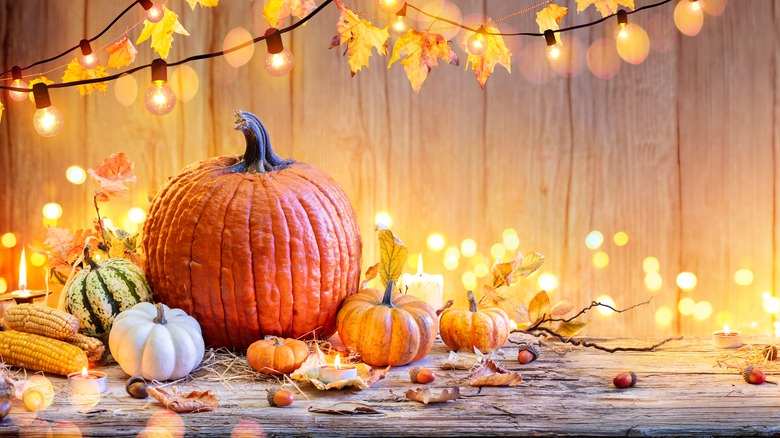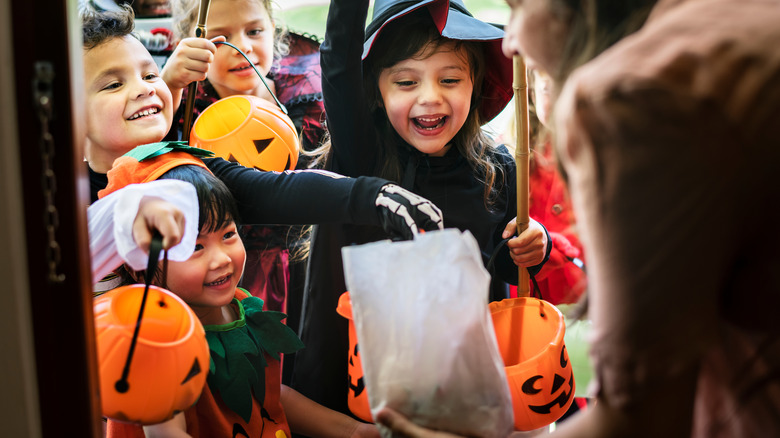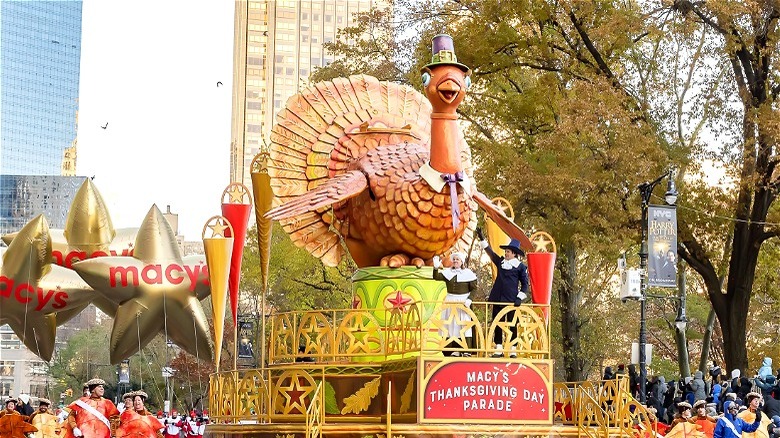The Direct Connection Between Trick-Or-Treating And Thanksgiving
Fall celebrations are starting to commence and among the most observed holidays during the calendar year, Thanksgiving and Christmas reign supreme. In fact, Statistica found Thanksgiving to be the most popular holiday among Americans in 2021.
Even though November and December hold the most recognized holidays in the U.S., Halloween is still a seasonal celebration enjoyed by many individuals, both young and old. Among all the haunted decor, face-filled pumpkins, and Halloween party foods, roughly 60% of Americans have been celebrating Halloween every year since 2015.
According to Investopedia, holiday lovers show their Halloween commitment by buying elaborate costumes for spooky get-togethers and the highly-anticipated trick-or-treating event which happens across most U.S. neighborhoods at sunset on October 31st (via Parade).
History claims the tradition of trick-or-treating didn't become a yearly occurrence in the U.S. until the mid-1900s when Halloween's meaning began to shift and the holiday was transformed into a more communal festival. However, the concept behind collecting candy at your neighbor's door traces further back than you'd assume. The unique ritual used to hold a different name and meaning and unexpectedly, took place every year on Thanksgiving Day.
Ragamuffin Day looks a lot like modern-day trick-or-treating
Most people who celebrate both Halloween and Thanksgiving are probably unaware of the binding link that connects the two traditions. Trick-or-treating continues to be a long-celebrated pastime by thousands of American children but did you know the general concept used to be celebrated on Thanksgiving? Dressing up and going door to door in your neighborhood asking for candy looks a lot like Ragamuffin Day which, according to Atlas Obscura, became extremely popular in most New York communities soon after Abraham Lincoln made Thanksgiving a national holiday in 1863.
NPR claims on Thanksgiving Day in the early 20th century, children dressed in old clothes traveled door to door asking neighbors if they had anything to spare. Historian of the New York public library, Carmen Nigro told NPR "the usual response would be pennies, an apple, or a piece of candy."
The event was deemed Ragamuffin Day due to children's dreary beggar-like attire but children weren't the only ones dressing up on Thanksgiving Day. In the early 1900s, adults participated in Thanksgiving masking as well, wearing all kinds of costumes including adornments that mocked other nationalities, all for the purpose of celebrating the day's unity as Americans (per The Atlantic).
Raggamuffin Day was eventually considered an annoyance among those wanting to celebrate Thanksgiving without beggars at their doors (via NPR). One specific strategy used to deter masking paved the way for yet another unanticipated holiday tradition to unfold.
From Ragamuffin parades to Thanksgiving Day parades
According to NPR, the superintendent of schools in New York at the time, William O'Shea, was the first to publicly speak out against the prevalence of "Ragamuffins" on Thanksgiving, yet one group of young boys tried to cultivate more order around the holiday by creating parades. The New York Public Library claims by 1940, the Madison Square Boys Club held annual parades with as many as 400 children and wore costumes other than tattered clothes. However, the last official Ragamuffin parade was recorded in 1956 since a newer, bigger parade was becoming increasingly popular.
History claims the Macy's Thanksgiving Day Parade debuted in 1924, not as a celebration of the late November holiday, but to increase excitement over Christmas. Few New York children could resist the giant colorful balloons and zoo animals that dawned New York's city streets on Thanksgiving morning. Macy's declared the company would host another parade the following Thanksgiving and the event's success only grew from there.
Brittanica notes the popular 1947 film, "Miracle on 34th Street" only amplified the parade's popularity due to its parade-focused plot: the annual event eventually became a Thanksgiving holiday tradition for most Americans. The notion behind today's trick-or-treating may harken back to early 20th-century Thanksgiving celebrations, but economic hardships and cultural shifts made way for new traditions to form and take shape across the country.


